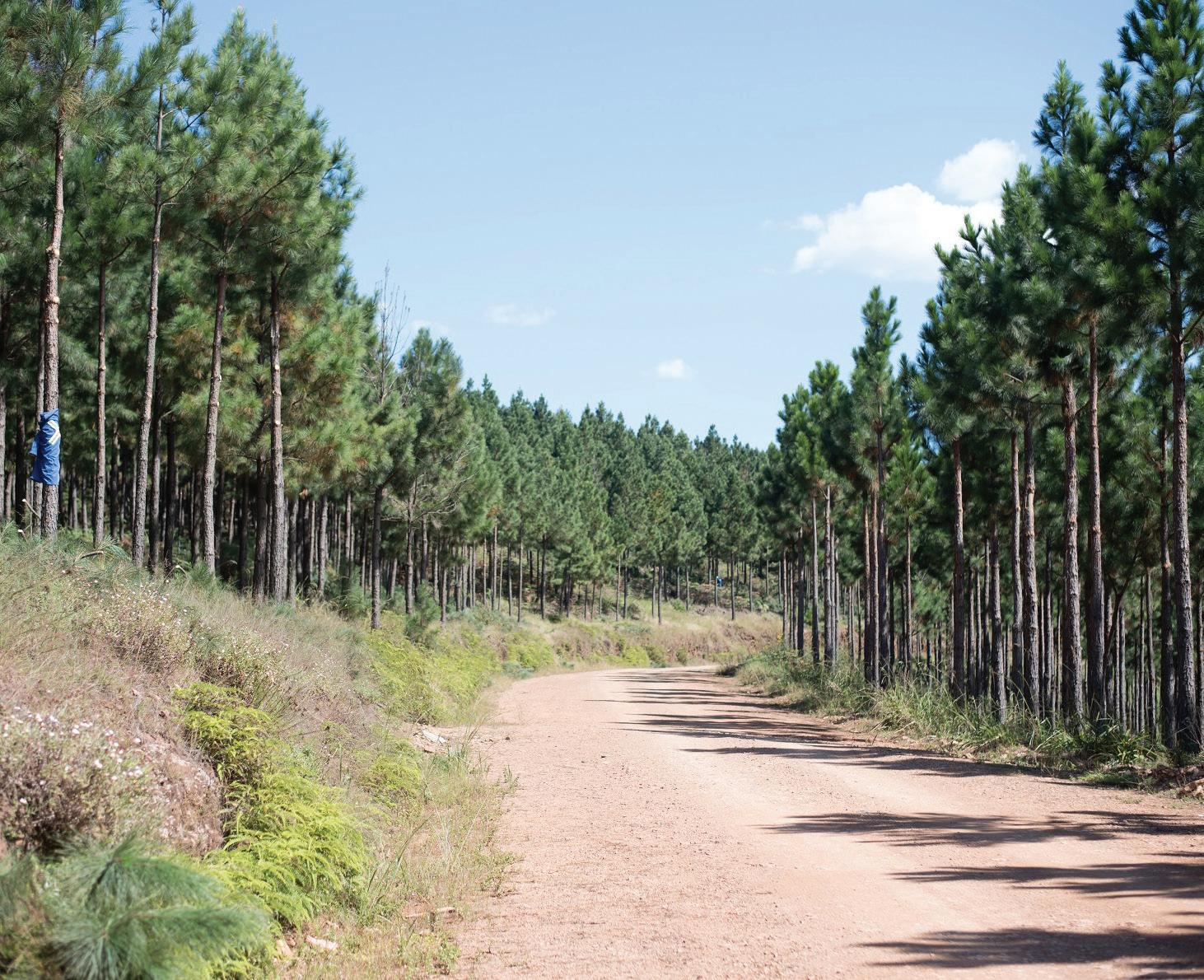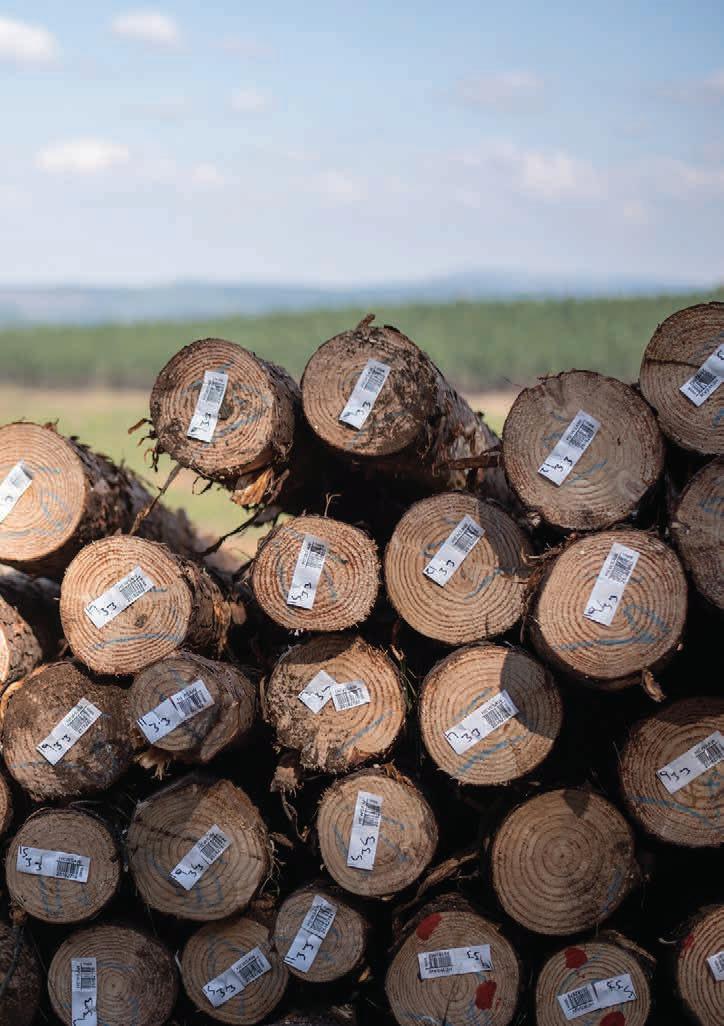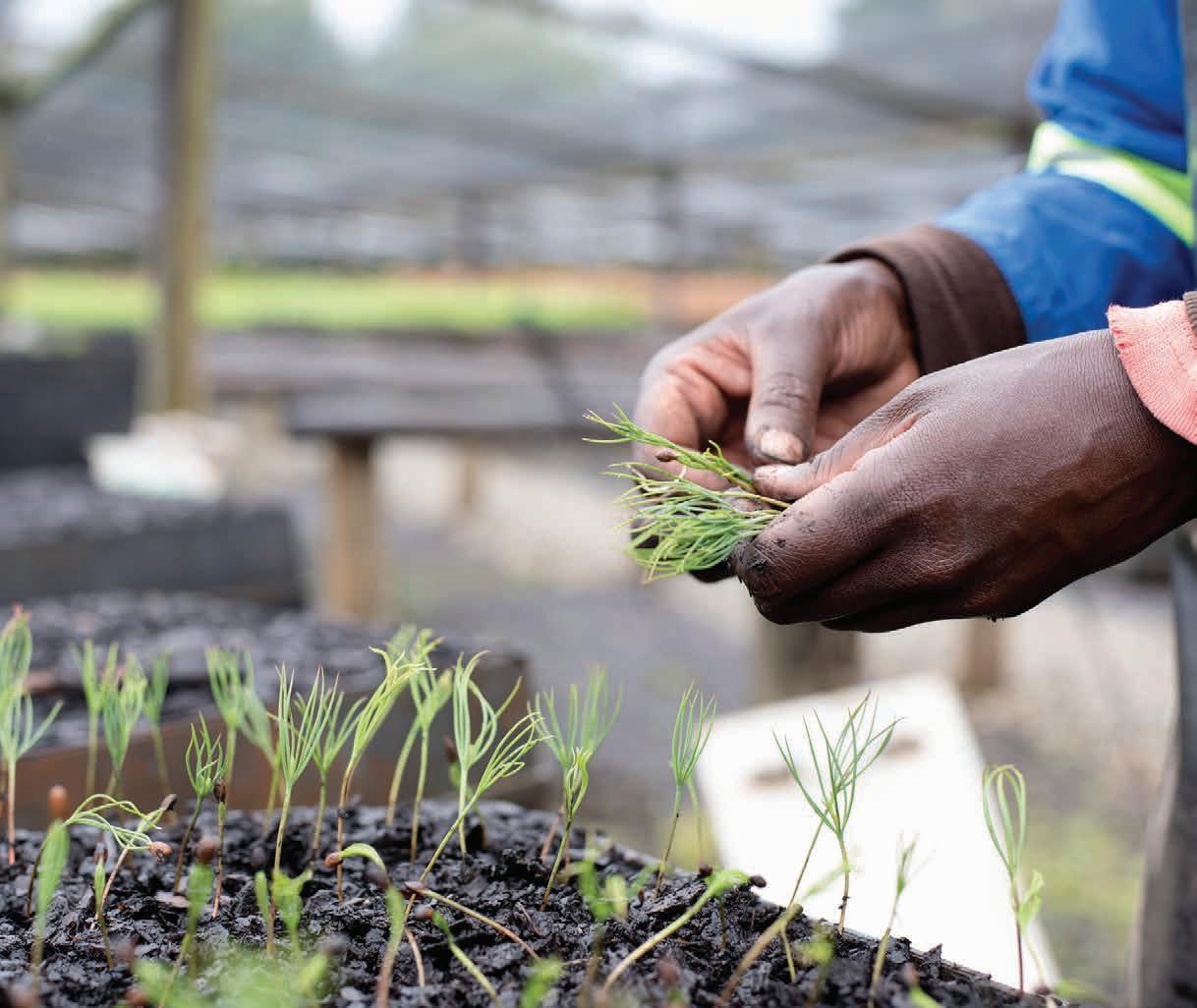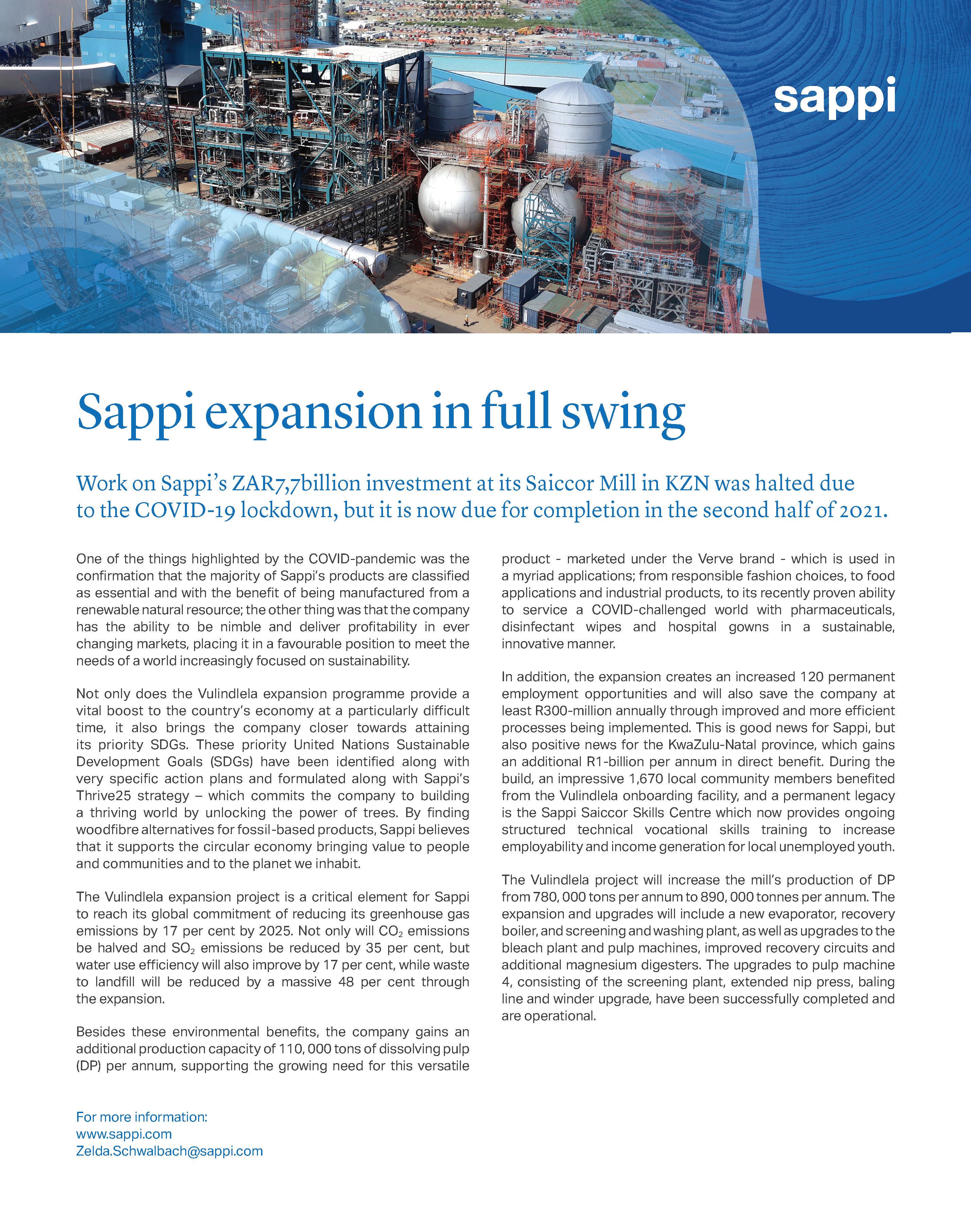
10 minute read
FORESTRY

GROWING UP
The new Forestry Master Plan aims to revitalise the industry and boost South Africa’s troubled economy. Experts weigh in on its potential. By
DELIA DU TOIT

The new Forestry Master Plan, fi nalised late in 2020, has ambitious goals. It aims not only to secure 151 000 hectares (ha) of new forests and procure R36-billion in investment, but also to create more than 100 000 new jobs – at a crucial time.
Though the plan has created much excitement and already delivered on some of its tenets, including R10.2-billion in investment, many in the industry are sceptical after decades of being let down by government’s execution of similar plans.
This time, though, things could be different, Michael says Michael Peter, Peter executive director of industry representative Forestry South Africa. “Indeed, the industry has seen a great number of nationally approved plans that have never been executed. The failures can be squarely attributed to the lack of political will from a long list of ministers in forestry and water, and a lack of service delivery and accountability. We have even seen instances where, in our view, offi cials have sabotaged the implementation of the state’s plans with impunity.”
Peter says that in this case, however, the plan is not an isolated initiative, but rather a result of the Public Private Growth Initiative that the industry negotiated in 2019 with President Ramaphosa. “The industry has committed to massive targets on investment, employment and transformation. The president, the Department of Environment, Forestry and Fisheries (DEFF) and others must, in turn, deliver the structural, legislative and administrative reforms needed to unlock these opportunities. Delivery failures by the state will invoke presidential-level intervention. We have already experienced an example of this in a six-year-long struggle with the Department of Water Affairs where the presidency intervened.”

THE PLAN
If implemented well, the plan will ensure almost 200 000ha of forests through afforestation and recapitalisation of DEFF-owned plantations. This will create the bulk of the planned 100 000 new jobs, around 60 000 and 20 000 respectively, though it represents only a small portion (R1.6-billion) of the investment target. The bulk of that remaining R34-billion will come from large companies involved in the pulp and paper, sawmilling and board manufacturing subsectors.
It also aims to remove many stumbling blocks in the sector, including fi nalising land claims, addressing plantation theft and crime, promoting the use of timber as a green building material, and fi nancial support to replant pest-damaged plantations in KwaZulu-Natal and fi re-damaged areas of the Western Cape.
SHORTFALLS AND PITFALLS
Many industry insiders are not convinced. Dr Jaap Steenkamp, CEO of the SA Forestry Contractors Association, says fi re damage is just one case in point. “Two major fi res ravaged the Southern Cape in 2017 and 2019. Private companies in the area replanted every hectare lost, yet the state did not plant one single hectare on the available 20 000ha. The fi re danger is increasing daily, the cost of replanting is going through the roof, and we estimate it is costing the George economy around R800-million annually in lost jobs, among other factors. Why will the execution of such issues be different with the master plan?”
Dave Dobson, owner of Umziki Forestry Consulting, has similar doubts. “Similar afforestation targets have been bandied about
INHIBITORS IN THE SECTOR. ” – MICHAEL PETER, EXECUTIVE DIRECTOR, FORESTRY SOUTH AFRICA

Harvesting Nursery

DID YOU KNOW?
Forests cover around 40 million hectares of total surface area in the country and are mostly made up of savannas. Plantations contribute fewer than 1.3 million hectares to that number, and natural indigenous forests such as Knysna and Tsitsikamma cover less than 1 million hectares.
Source: Department of Agriculture to Environment, Forestry and Fisheries
for too long, while communities see no real change. The only successful afforestation I know of in the Eastern Cape, for example, was done by community members who borrowed the money to plant 1 300ha after realising they couldn’t rely on government. This has been going on for 20 years despite several plans, and I don’t see why it would change now.”
And municipal forests in a state of disrepair have long been hurting the industry – yet are expected to create 20 per cent of proposed new jobs. One forest in KwaZulu-Natal, for example, was completely felled a few years ago to pay salaries and Eskom debts, and nothing has been replanted since, says Dobson.
Peter echoes this saying: “The recent Auditor-General’s report is revealing in this regard: failure to recapitalise state-owned forests is one of the main growth inhibitors in the sector. The master plan addresses this and other industry constraints like inhibitive regulation, service delivery failures by officials, and no state support for black timber growers. We now need to see action from the state in honouring all their commitments made years ago.”
THE WAY FORWARD
Recapitalisation of state and community plantations is crucial to the success of the plan, as these provide the feedstock to support the major investments in processing, says Peter. But the most exciting developments could come from the uptake and promotion by the state and private sector of timber as a sustainable, renewable and carbon-beneficial material in the built environment.
“South Africa lags decades behind the rest of the world in this regard, largely due to the historical misperception that concrete and steel are more reliable and attractive building materials,” explains Peter. “Modern use of engineered wood products around the world has shown that this is not the case. The cost and comfort advantages of timber are slowly being recognised in the architectural and building industries, and the recently introduced carbon tax could accelerate this.”
Dobson believes this solution could be twofold. “You can build a two-bedroom house from a modular pack in just two days for around R100 000. Other countries live in timber frame houses, but we never had this tradition because in the past there just wasn’t enough timber. Yet it could stimulate the industry and would help solve our country’s severe housing issues.”
If ever there was a time for the industry to boom, this could be it. “Through the growing trend of conscious consumption, people are becoming increasingly aware of the benefits of timber products over their alternatives – from packaging to plant-based plastics,” says Peter. “It’s clear that the sector will contribute significantly to the country’s green economic recovery. The next step will be to retain the momentum created by the plan, work hard toward its implementation, and keep pressure on government to do the same.”
SA FORESTRY BY NUMBERS
Commercial forestry makes up just 1 per cent of South Africa’s 122 million hectares of arable and grazing land, yet is responsible for 9.8 per cent of the country’s agricultural gross domestic product (GDP) and 4.9 per cent of its manufacturing GDP, making it one of the top ve sectors in manufacturing.
With an export value of over R38.4-billion, it is a key contributor to South Africa’s economy and a major employer – well over half a million South Africans rely on the sector for their income.
Mpumalanga and KwaZulu-Natal have the most land devoted to plantations of all the provinces, each contributing about 40 per cent to total forest hectares in the country.
Pine trees ll almost half of South Africa’s plantations by hectare, followed by eucalyptus trees (43 per cent).
Source: Forestry South Africa


TREES OF PLENTY


Using half a tree is so last century. New innovations offer green alternatives, extracting optimum value from each tree and eliminating waste. By NIA MAGOULIANITI-MCGREGOR
FAST FACTS
• ne large tree can provide a day’s supply of oxygen for up to four people. • Compared to other large-scale crops, tree plantations release 10 times as much oxygen. • ylitol was rst discovered in the 1 90s by scientists in rance and ermany, but only became popular as an arti cial sweetener after orld ar II when urope was experiencing a sugar shortage. • The carbon absorbed by plants during photosynthesis is locked up in paper products during their lifetimes.
Sappi’s reimagining of a circular economy and extracting maximum value from wood fi bre by using the full potential of each tree necessitated a few things: innovative in-house technology; some number crunching alongside projections of the economic solidity of the path ahead; and a commitment and determination to developing biorefi nery capacity. The new pilot furfural plant near Saiccor Mill in KwaZulu-Natal, set to be operational by next year, is a prime example of this.
Furfural is a versatile, sustainably sourced biochemical that replaces oil-based chemicals used in a variety of applications including resins, crop protection products and solvents.
“Sappi will be using technology developed in-house to assess the feasibility of a future commercial furfural plant,” says André Oberholzer, the company’s group head of corporate affairs. If the results of the pilot project prove successful, the plan is to make the plant “one of the largest, lowest-cost, and most sustainable production facilities in the world”.
Sappi Biotech executive VP Louis Kruyshaar says: “Industrial outcomes can vary from those in laboratory settings. Only once a small industrially representative pilot plant is optimised do we build a full-scale industrial option. It’s a step-by-step risk-management process essential in building a sustainable, credible and profi table business.”
He adds that the company is looking at opportunities adjacent to its core business, including biomaterials and biochemicals. “Sappi has developed a technology to extract hemicellulose sugars at Ngodwana Mill in Mpumalanga. This product is a core ingredient of the low-calorie, diabeticfriendly sweetener xylitol.
“The company already produces lignin – a renewable, organic natural polymer – commercially from its KwaZulu-Natal-based Tugela Mill,” says Kruyshaar. “Lignin-based dispersants and binders are increasingly in demand by customers who favour green alternatives.”
Sources: Sappi, www.patrickholford.com
SPLINTER CELL
Kruyshaar adds that as a new tree can be grown where a mature tree has been harvested, “wood is an ideal natural resource for biomaterials”. He explains: “This biomass cycle reduces carbon footprint and underpins our belief that commercial forestry and forest conservation can live together.”
Consumers are increasingly demanding more sustainable and environmentally friendly solutions, Kruyshaar says. “Consumers are reading labels and governments are regulating or legislating to reduce pollution and carbon in the atmosphere.”
Besides consumers and the good of the planet, there is a further cherry on the sustainable cake, says Oberholzer. “From an HR point of view, it’s much easier to attract good, young talent when you’re developing products and solutions for the future. And that invigorates us as a company. It’s not just a responsibility; it’s an opportunity.” Sappi’s biomaterials include nanocellulose, used as suspension stabiliser in paints and cosmetics, or as bio-based barrier material in green packaging. “Our cellulose-based fi bre plastic composites offer a renewable solution, which is all part of this green planet-friendly offering,” says Kruyshaar. “The company is developing demand for fi bre-based composites and nanocellulose before scaling up production further.”
While traditionally about 50 per cent of a tree mass is used to make paper, with the remainder being burned for energy, Kruyshaar says using half a tree for its cellulose content is “no longer an option. The previously unused 50 per cent, lignin and hemicellulose, will now provide green speciality chemicals and alternatives to oil-based products. There is an unstoppable move towards speciality chemicals and alternatives to oil-based products. There is an unstoppable move towards renewable sustainable resources.”
Louis Kruyshaar











